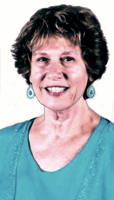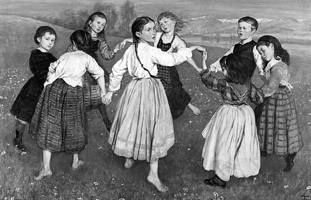
|
Folk Dance Federation of California, South, Inc.
|

|
CLICK AN IMAGE TO ENLARGE
International folk dance for children is an activity richly woven with educational, artistic, and kinesiological elements.
The emphasis of my approach for teaching is to combine these elements in a joyous and fulfilling experience.
Preliminaries
 In setting up my teaching method, it is necessary to find out key preliminary information. The work space available will determine the context for the class. It is important to select a suitable indoor (classroom, auditorium, community center, dance studio) or outdoor (school playground, campground, park) location. Temperature and climate must be taken into consideration. Will it be too warm, cold, wet, or smoggy? Find out if the site has proper equipment, such as a tape recorder, record player, records, and tapes. Always ask for a blackboard, chalk, and eraser. Arrange to come to class early enough to see if the equipment is functioning and the room is set up adequately.
In setting up my teaching method, it is necessary to find out key preliminary information. The work space available will determine the context for the class. It is important to select a suitable indoor (classroom, auditorium, community center, dance studio) or outdoor (school playground, campground, park) location. Temperature and climate must be taken into consideration. Will it be too warm, cold, wet, or smoggy? Find out if the site has proper equipment, such as a tape recorder, record player, records, and tapes. Always ask for a blackboard, chalk, and eraser. Arrange to come to class early enough to see if the equipment is functioning and the room is set up adequately.
Expectations from the class will vary according to the ages of the children – grade school, junior high school, or high school.
The size of the class is also very important. Overcrowding can easily ruin the experience of teaching and learning, no matter how correct everything else is! Although I have worked with up to forty children at a time, ten to fifteen seems optimum. The large class can be divided into two sections: one half functions as the audience, the other half as the dancers, then the groups switch roles.
Generally, thirty minutes to an hour is an average class. If the class is too short, not enough will be accomplished. Everything will seem rushed and incomplete. If the class is too long, the attention span and interest will fade.
Purposes in Teaching Folk Dancing
Folk dance instruction does many things for children:
- It provides an important supplement to their academic program in history, geography, social studies, current events, foreign languages, and anthropology.
- It also awakens an appreciation of various world cultures through dance, music, and related materials.
- It teaches children about themselves and others within a social context. It helps boys overcome the stereotype that "boys are sissies if they dance" and teaches boy/girl dynamics.
- Students who speak English as another language (in some families, two or three languages are spoken, and English may not be one of them) in the home can feel successful in this nonverbal activity.
- It is also good exercise and helps improve posture, coordination, balance, and develop locomotor skills.
- It helps develop an appreciation and a recognition of the basic elements of music.
- Folk dance also is fun. Everyone participates in a group activity in which the atmosphere is relaxed, yet enthusiastic and energetic.
Material
The next step is to select appropriate material. The actual dances, with repeatable steps and patterns, are the vehicles to a successful program. Taking into consideration the above key points and goals, I determine what dances to use for each teaching situation. Plan to bring more dances than needed in case of last minute changes.
Teaching Hints
After the class arrives, I introduce myself, then I introduce the first dance, and give the origin and some background information for it. I ask the children to take a specific formation. Usually, the first dance is a circle dance – either open or closed. This allows everyone to participate and feel comfortable with a new situation.
Most often, I demonstrate the first step with and then without music. I break down each stelp in turn to the simplest form possible. The children try it, first without music a few times, then slowly with music. Then I increase the speed. If it goes well, I teach the next step or steps, going from the easiest to the most difficult material. Sometimes, it is necessary to leave a step untaught the first few sessions. If the children get restless or tired, I move on to something else. If a dance doesn't work, don't insist on forcing it; simply shift to another dance.
Teach the dance correctly, but if you are reviewing at a later time, don't harp on "Lefts" and "Rights" unless absolutely necessary to the success of the dance. Ask once in a while if they know why they must use the left or right foot in a particular step of the dance. Let them become a part of the total learning process.
Hands arre held in many dances. I ignore the boy/girl game as much as possible and it seems to diminish. I use the verbal cue "Loosen up" to remind students not to grip so hard. Most children want to cooperate. If a dance calls for partners, the classroom teacher usually handles if for me, or I ask the children to pick partners of their choice.
I have found that most children, even the most energetic, active and boisterous, want to participate. Once in a while, if a child's or group energy gets out of hand, it is necessary to take action.
Remind the children that mistakes are a natural part of learning something new. We then can stop and view that part of the dance more carefully.
End of Class
At the close of the class, I usually feel exhilarated and tired at the same time. I have made new friends and have shared my lovely hobby and art form with children of all ages and backgrounds. After each folk dance session, I want them to take away the essence of our time together. If they are a little more sensitive and aware of themselves and each other, as well as the material covered, I'm satisfied.
I would like to see International Folk Dance become a part of the regular school curriculum at all levels. Because of its importance and value in so many areas of the child's development, it serves as a catalyst in awareness. We need to be willing to learn and share more about teaching folk dance to children.
Used with permission of the author.
Printed in Folk Dance Scene, January 1983.